| Article ID | Journal | Published Year | Pages | File Type |
|---|---|---|---|---|
| 58936 | Chinese Journal of Catalysis | 2015 | 10 Pages |
The dry reforming of coke oven gas (COG) to produce syngas was performed over La0.6Sr0.4NixCo1–xO3 catalysts in a fixed-bed reactor at 800 °C. These perovskite-type oxides were synthesized using a sol-gel method and characterized using X-ray diffraction (XRD), N2 adsorption-desorption, temperature-programmed reduction of H2, scanning electron microscopy, transmission electron microscopy, and thermogravimetry-differential scanning calorimetry. XRD results showed that the La0.6Sr0.4NixCo1–xO3 perovskite-type oxides formed quaternary solid solutions. The effects of the degree of Ni substitution (x) and the catalyst calcination temperature on the dry reforming of COG were investigated. XRD analysis of the tested catalysts showed the formation of Ni0, Co0, and La2O2CO3, of which the latter is the main active phase responsible for the high activity and stability, and the suppression of coke formation under severe reaction conditions. COG rich in H2 can also reduce the formation of carbon deposits by inhibiting CH4 decomposition.
Graphical AbstractCO2 is adsorbed on a La2O3-SrO, matrix producing SrCO3 and La2O2CO3, the active species for CO2 reforming of COG; these species inhibit carbon formation by reacting with CH4 to reform CO and H2. The reaction of carbonate species with surface carbon species occurs at the metal sites, converting the carbon species to CO. COG containing abundant H2 can also reduce the formation of carbon deposits by inhibiting decomposition of CH4.Figure optionsDownload full-size imageDownload as PowerPoint slide
